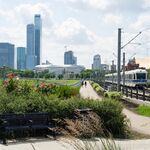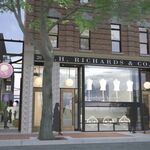I know the City plans for LRT, but I don't agree with them. I look to San Francisco as a viable example of what could be. That City has BART (Bay Area Rapid Transit) which connects San Francisco proper with many of the outlying communities, including Oakland and supports, in-City, a number of stops along a commercially oriented right-of-way -- smooth and efficient. The Cable-car network actually reaches more of the inner-City venues. It is clunky, inconsistent from a time perspective, crowded (typically), expensive to ride (fares are in the $6.00 range) and the operators (grip-man and conductor) are rude and insolent in a sardonic and alternative-humor kind of way. But, boy is it popular -- over 7 million paid fares per year (I say "paid fares" because it is not uncommon for a rider to get to a destination without being taxed by the conductor and I have seen the odd conductor wave the fee for a "pretty young thing". I used to do a lot of work in Oakland and so I was a regular rider on BART, but downtown SanFran I greatly preferred the Cable Cars. Nobody talks to one another on BART -- riders glumly live in a self-centered world of introspective silence, waiting for their destination to be perfunctorily announced. On the Cable Car everyone is chatting, smiling and almost sad at the ending of the trip.
So I would like to see Edmonton's equivalent -- the ERR (I love the acronym) -- expand to those "touristy" neighborhoods (especially Old Strathcona, where a sleek LRT train would tend to ruin the ambiance) and connect it to some other growing destinations -- U. of A., Bonnie Doone Centre (soon to be a significant node regardless of transit preferences).
I had proposed to the City a couple of things:
1. change the mode of propulsion for the Streetcars from an overhead power line (ugly) to an in-ground (unseen) LSM (Linear Synchronous Motor) system with the activator located on the undercarriage (also unseen) of the motorcar. This would enable better controlled arrival and departure times and centrally controlled operation, freeing up the motorman to engage the public. I suggested bridging 105th street, 104th street, Gateway Blvd. and Whyte Avenue on a line extension that would remain aerial all the way south to 68th Avenue (the Richie Market neighborhood). The line would then run on surface tracks along the green belt north of 68th avenue (once a CPR spur) east to Mill Creek Ravine where it would bend northwards along the original route of the CPR line that crossed over the Low Level Bridge -- a very nature-oriented scenic route adjacent to the creek known as Mill. Ultimately it would end up at the Muttart conservatory, thereby connecting two LRT stations -- Muttart and Grandin. Also special accommodation would have to be made at stops along the route to promulgate disabled access.
2. a new route that would run along Whyte Avenue west to 112th street where it would run north parallel to the LRT line one block to the east but catching some of the densification of the high-rise apartments on that street, enticing university students aboard for a trek to Old Strathcona. At 87th Avenue the route would bend eastward to 109th Street catching a bit of Garneau that is also scheduled to intensify from a development standpoint, there wending southward along 109th street to Whyte Avenue and the twin eastward route. In the other direction, the streetcar line would head eastward under the sister bridge/station at Whyte and Gateway (connector point) and over the Mill Creek extension (another connector point) and end up with a short northward jog along 85th street at the west side of Bonnie Doone, justifying (between Streetcar network and LRT) a major mixed-use redo of Bonnie Doone Mall.
The east-west leg of LRT, I would suggest, should begin at 76th Ave. and 114th Street at the McKernan Belgravia station (existing) and run straight eastward along 76th Ave., bisecting the undeveloped CPR lands (both the LRT and the Streetcar system would greatly enhance the viability of the CPR lands and help expedite their development), and continuing straight east all the way to Sherwood Park where ridership aplenty waits to be tapped. Certainly this line would be simpler to build and far more efficient than running through Old Strathcona from who-knows-where at U of A .
If the LRT line uses the high level bridge as a river crossing, huge upgrades would be required to the bridge and you could also wave bye-bye to the existing ERR that traverses that crossing now

. And where would it go from there? My solution is neat, economical and tourism-promoting, all at the same time. It connects neighborhoods in a friendly fashion and would be extremely well received by the Old Strathcona Foundation and the Old Strathcona Business Association. And you get two... two... two systems for the price of one, with a different kind of ridership on each.






